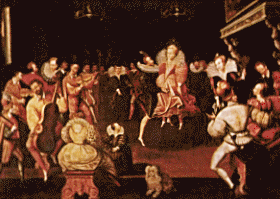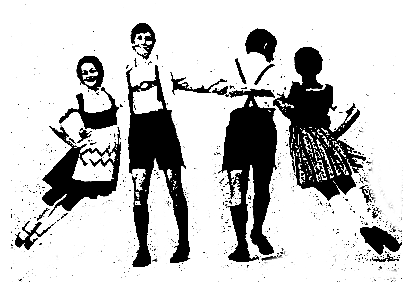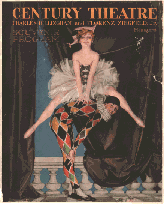Nothing new under the sun...

Her Majestie Queene Elizabeth I Jammeth with the Duke of Leicester in "Ye Swyngge Circle"
(See notes in text)
Aerial Origins
By: Iver Cooper
Most Lindy-Hoppers have heard the story of how Frankie Manning invented the first air-step. But there has been little speculation (at least in print) as to what inspired the ones which followed.
Unless the old-timers remember, and are willing to tell us, all we can do is guess. Here are a few suggestions as to possible sources of inspiration:
- Folk Dancing
- Exhibition Ballroom Dancing
- The Circus
- Vaudeville Acts
- The Theater
- Sports
- Martial Arts
I know more about folk dancing than about any of the other subjects, so I have written more about it. But that does not mean that I consider it to be the most important influence.
Folk Dancing
Sue and I were talking about where aerials and drops came from at Vienna Grille last week, and I mentioned to her that some folk dances featured acrobatics of one sort or another.
The extent to which those who developed Lindy Hop would have been exposed to European folk dances is uncertain to me, although Harlem of the period 1910-1935 was a diverse neighborhood. Bob Boross of Western Kentucky University has written about the history of jazz dance. He mentions (citing Stearns) William Henry Lane (1825-1852), who lived in the Five Points District of Manhattan. His dancing was said to be a combination of Irish jig dancing and African rhythm.
For the moment, let me at least review what they COULD have seen.
Russia and Ukraine:
no aerials/drops for the ladies, but the gents get to do eagle splits, squats with leg thrusts (prisyadkas), coffee grinders (leg circles in a squat position),and more. There are two man figures in which one flips or throws the other. The Hutzul people of the Ukraine do a figure called Gvizda (in the dance Arkan) in which every other man in a circle slides his legs toward the center, presses them together to form a star (Gvizda=star), and then fishflips out. (I did this figure in my nearly forgotten youth, when I danced with a Ukrainian group).
It is quite certain that vaudeville dancers in the New York area were exposed in the early 1900s to Russian dancing, and that, in the period of 1910-1925, modified Russian steps were used in acrobatic finales to vaudeville routines. Ida Forsyne saw a Russian company on Broadway in 1905 and, in 1911, incorporated Russian kazatskis (squat kicks) into her eccentric dance routine. Rufus Greenlee copied steps from the Alexander Russian Dancers at Coney Island in 1910, and, by 1914, he and his partner Thaddeus Dayton had an all-Russian finale. As early as 1917, Willie Covan took the Russian/Ukrainian step called a "coffee grinder" (tappers call it "Around the World", which, unfortunately, is a name that Lindy Hoppers give to an air-step) --you squat on one leg, and scythe the other leg around in a circle, transferring weight briefly to your hands as the scything leg comes around behind--and fancied it up, eventually arriving at a double "Around the World", i.e., alternating the scything leg, with NO hands. Dewey Weinglass also did a step he called a Flying Eagle. While Stearns says that Dewey invented it, it is a well known Russian variation on the kazatski, in which the legs go to the sides rather than forward.
Romania:
In Cluj-Napoca, Transylvania, in 1980, I saw a couple do a figure in which the man and woman were side by side, the man did a kick forward, and then fish flipped.
Hungary:
In the Paloc region in NE Hungary, there is a couple dance figure which is somewhat like a "toss away".
For that matter, a St. Louis Shag type "falling off the log" is done in the Legenyes (lad's dance) from the Kalotaszegi region (now politically part of Romania). That's not really an aerial or drop, but I couldn't resist mentioning it.
Poland:
In the Oberek, there are many kneels and leg pivots for the man (some of you may have seen me throw these into my Lindy routine at a recent jam session at Glen Echo), combining them with a Lindy lockup (suggested to me by Ryan Francois). For the woman, the Oberek from Opoczyn features a move in which does a flying jump (parallel to the floor) and is caught and spun about by the man. Another dance, Jacok, has the woman jump off the floor, bringing her feet underneath her and bending her knees, while the man pivots so she circles about him. In Krakowiak, there is a move in which one partner squats with one leg extended while the other partner circles (and thereby spins) the squatter
Germany:
In Zillertaller Laendler, there is a pretzel move which begins with the woman kneeling. Also, the dance ends with the woman jumping up and locking her arms, the man holding her above him.
In Kreuz Konig, a two couple dance, a flying wing is formed in which the woman are on the outside and let their legs fly out to one side. This dance was created in the 20s.

Does this look like Gay and Dave and Steve and Sue?
The illustration shows a team of German dancers doing this figure, which they call a "weathervane". (I also found a photo of Scandinavian dancers doing it. No, not at Herrang!)
England:
In one of the Morris dances, there is a figure in which one dancer leapfrogs over another.
Croatia:
Dancers form a circle with Men and Woman alternating, with a "back basket" hold. The dancers do a kind of buzz step and, when enough speed is attained, the woman let their legs fly out (radially).
Brazil:
I don't know too much about it, but Capoeira is essentially a martial arts practice disguised as a folk dance. It has lots of flying kicks. If you look at the photo gallery on the website, you will see some interesting acrobatics. One can well imagine blacks of Brazilian descent bringing Capoeira to NYC. [Editor's Note: one of our fashion books mentioned Brazil as a very likely source of the Zoot Suit as well] A local source for Capoeira is: Cobra Mansa; 5924 Georgia Ave. NW; (202) 723-5565
Greece:
In the Tsamiko, a line dance, the leader is allowed to do acrobatics, and is supported by the second dancer in the line. (The third dancer keeps the basic step going for everyone else). Often, the lead and the second are connected by a kerchief, rather than by holding hands directly. Some of the moves include:
- drop into a squat on the left foot, and spin around a couple of times with the right leg extended;
- squat on both feet in an open position, while bending backwards, bringing the body parallel and close to the floor (ideally, this is done holding the scarf in one's teeth, and hanging down from it); and
- a handstand on the right hand only.
In Zembeikos, a solo dance, sometimes one man will jump into a straddle position on another.
Macedonia:
The woman don't do much, but the men drop to their knees and do knee turns. (Sometimes jumping off the floor from a full kneel, turning once in midair, and landing on their knees again.)
Ballroom Dances
The real origin of the Waltz is rather obscure, but a dance of turns and glides, leaping and stomping appeared in various parts of Europe at the end of the 17th and beginning of the 18th century. In Italy it was the Volta, France has its Volte, Germany the Weller and Austria had its Landler. These were round dances but at the end of the dance itself there was a short period in which the circle would break up into couples who would whirl madly round and round and finish with a jump in the air. In the Landler the hopping gave way more to a gliding motion and that is why it is considered the forerunner of the Waltz. [Editor's Note: The film Groovy Movie, starring Tom K's favorite Jean Veloz, also mentions the impact of Waltz on Lindy]
La Volta, a Renaissance predecessor of the Waltz, is worthy of special mention. The lady sits on the man's raised right knee and he turns about. It is described in dance manuals. I have attached an illustration of an oil painting by an unknown artist, ca. 1600 A.D., in collection of Viscount De L'Isle, Penshurst Place, Kent, U.K. It is entitled, "Queen Elizabeth I doing a leaping turn of the 'Volta', assisted by Earl of Leicester". This was a contemporary political lampoon, not the medieval equivalent of papparazzi snapping photos at a society ball.
In 1907, Maurice Mouvet and Madelaine D'Arville introduced their "Dans Apache" ("wild dance", nothing to do with native Americans) at the "Cafe de Paris" cabaret in Paris. According to my friend Don Herbison-Evans, whom I have corresponded with on the subject of computer animation of dance and dance notation systems, this was done to a slow Waltz, and depicted the jealous relationship between a young thug and his girlfriend, involving lifts, falls, and other acrobatics. He has also pointed out that as early as 1912, Vernon and Irene Castle were doing lifts. (Of course, that leaves us with the question, what gave THEM the idea?)

Jack Clifford and Evelyn Nesbitt
In 1915-1917, Jack Clifford and Evelyn Nesbit (the "Girl in a Swing" in the Harry Thaw-Stanford White scandal) performed a whirlwind ballroom routine at Hammerstein's vaudeville house; as the photograph shows, this ended in what a Lindy Hopper would call a cradle, although the man continues to hold the woman, allowing her to keep her legs straight.
Sports
My candidate for the first documented aerial (although not the direct inspiration for Frankie) is the ancient Minoan sport (or religious ritual) of bull leaping, which can be dated back to the 16th century BC. This Website has more information on said practice.

Hitting the Breaks with Ferdinand
The fresco (above) is from the East Wing of the Palace of Knossos, and is dated to the 15th Century B.C. Note that it shows the three phases of the sport: (1) preparation, (2) leaping, and (3) landing. It is unclear whether this is intended to represent the three stages or three individuals performing. The file is provided courtesy of the Iraklion Museum.
I am still researching the history of gymnastics. I don't know whether gymnastics was taught in public schools in NYC in the Twenties or Thirties.
Pairs Ice Skating today features many lifts and drops, but I am not sure yet when they entered the sport.
The Circus
Perhaps a more likely source of ideas for Lindy aerials and drops would have been the theatre and the circus. Mock swordfights, villains carrying off heroines, tumbling, pyramids, etc., could all have been grist for the mill.
The earliest circus acts were equestrian numbers; you know, daredevils on horseback, doing things like handstands. (Editor's Note: DC Lindy Hoppers Andy Wallo and Jeff Booth actually do this!) Which gives me the excuse to digress a little. The Guardian reports that the organizers of the Australian Line Dancing Championships couldn't believe it when a family included a horse in their team for the duo, trio and small group sections of an upcoming competition. However, after seeing a video of "Chrissy", the judges were sufficiently impressed to let her join in.
With regard to the circus and a suggestion from Judy Pritchett) I found that, Christian Batchelor, (This Thing Called Swing) states, "The dancers started going to circuses, watching acrobats to get ideas for new steps. 'Two fellas in the show, the one guy laying down, and he picked the guy up with his feet on his stomach, did a flip backwards, so we decided that we can do that,' says Frankie." (pp. 190-1).
There is no doubt that blacks were exposed to circuses at an early date. Archie Ware, born in 1892, remarked about his childhood in Chicago, "Flat-ground tumblers were what I loved. My pals and I, we watched what they did at the circus and went home and tried it.... I shiver when I think of the crazy stunts we tried to copy. It's a wonder we didn't kill ourselves." (Somehow, this reminds of our current Glen Echo dances.) Archie at 14 joined a vaudeville act.
Not only could blacks have gone to the circus, and seen acrobats there, some blacks were IN the circus. When the Cakewalk became popular, the circuses added black performers to cakewalk for their audiences. For example, in 1902, Nettie Compton did a cakewalk for the Ponsell Brothers Circus (to be scrupulously accurate, I should admit that she had previously been part of a quartet in the circus' sideshow). Similarly, Slow Kid Thompson started with the Mighty Hagg circus as a cook but ultimately was drafted as a cakewalker.
Thus, blacks were exposed to the circus as spectators, workers, and performers.
Vaudeville Acts
Another inspiration was apparently Harold Nicholas. (Harold and Fayard Nicholas were a tap dance team that came to prominence in 1932. They were honored with the National Medal of Freedom in 1997. See our Interview with Fayard Nicholas) Frankie said that he had seen Harold Nicholas do a back flip, "so I did the same in the Apollo Theatre. I ran across the stage and ran up the wall and just did a back flip, just like that." (Batchelor, p. 191). I believe this is a reference to the routine Harold Nicholas did in the film Orchestra Wives, where he ran two steps up a wall, did a back flip, and landed in a split. According to their bio, the Nicholases drew inspiration from the circus themselves.
Ballet
For quite some time, I had assumed that blacks in Harlem, in pre-TV days, couldn't possibly have had any serious exposure to ballet. However, I ignored the possible influence of vaudeville.
Searching under "ballet" in the motion picture collection of the American Variety Stage, 1870-1920, I found 18 films with this keyword. While we are probably not talking opera hall scale or quality here, it means that those who went to vaudeville shows would get to see the more common ballet moves, including, I would assume, jetes, supported lifts, etc.
Slapstick comedy may also be worth investigating.
The Library of Congress has a page devoted to the "American VarietyStage: Vaudeville and Popular Entertainment 1870-1920".

Leapfroggin' at the Century
One playbill image (above) shows a lady leapfrogging over a man. Its provenance is: Charles Dillingham and Florenz Ziegfeld, Jr., present a musical entertainment entitled The Century Girl. The show was performed in New York City on Monday, November 6, 1916 at the Century Theater. [Editor's Note: Frankie Manning was 2 years old at the time... perhaps he saw it from his mother's arms. ]

You Must Have a Regular Partner to Do This
Above, we see a clip from a Thomas Edison film of a 1904 vaudeville act called "The Japanese Acrobats", which they describe as follows:
"An Oriental man and boy walk on a stage with a painted backdrop of a garden or park, give a slight bow to the camera as if it were an audience member, and remove their silk jackets. Both wear dark tights and leotards with light-colored slippers; the man also wears grey trunks, and the boy sports a white cloth around his middle. Lying on his back on a fitted mat, the man juggles and spins the boy with his feet. The boy's acrobatic movements include spinning in a tucked ball-like position, flipping lengthwise in a prone position, flipping from a standing position to a shoulder-stand, somersaulting from a standing to a sitting position, repeated flips involving both the hands and feet of the man, and other series of somersaults and turns. After finishing the act, the acrobats take a slight bow and run off the stage, then return for another bow before finally exiting."
[Editor's Note: Perhaps this was available for rental and Frankie and his friends got a copy of it.]
Summary
So the circus is definitely a source for Lindy air steps, although it is still possible that athletics, folk dancing, ballroom dancing, etc. played a direct or indirect role. I think that folk dances could have given swing dancers the idea that you could lift or drop (an unfortunate term, that) a partner. However, I do not recall seeing such common moves as the side cars, mop the floor, and the window shade in any folk dance.
I would like to thank Sue Fedor, Judy Pritchett, Don Herbison-Evans, our fearless editor, Queen Liz and the bulls of Minos for their contributions to this article. I wish to emphasize that this article is a work-in-progress; Frank will pass on to me any helpful comments.
Counter for the Entire Site (not just this page..)
Home | About Lindy | 1940s Collectibles | Upcoming Events | Vintage Clothes
The Guide - Establishments - Travel - Accessories
Music | Links | Photo Gallery | Extras | Contact